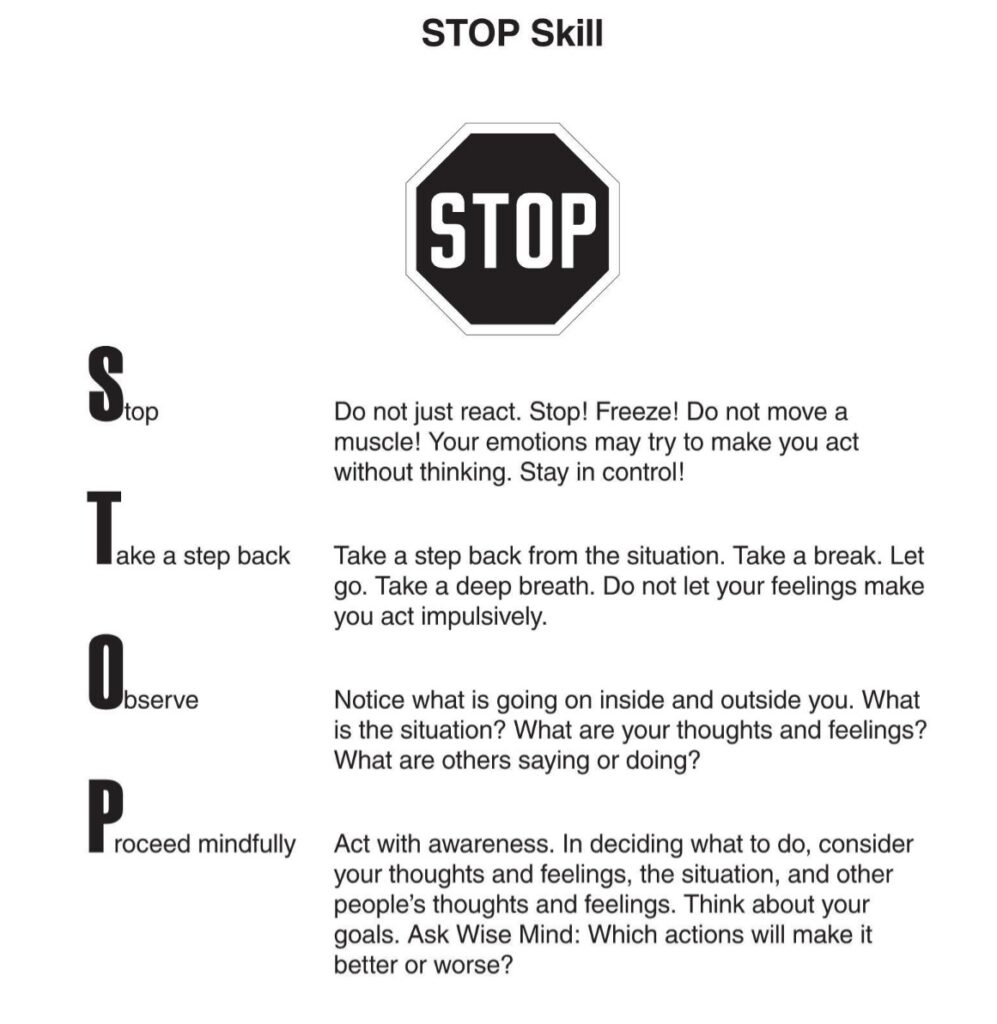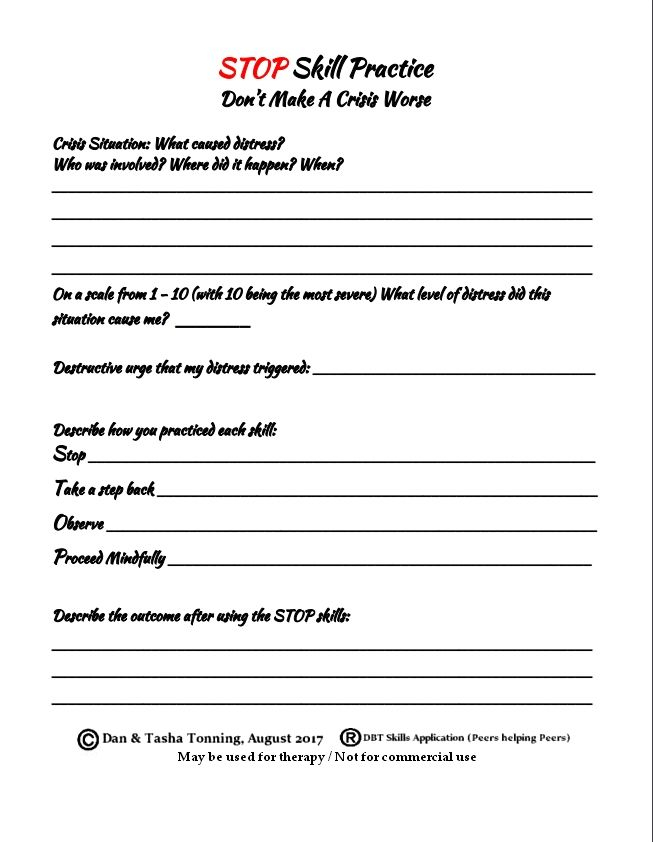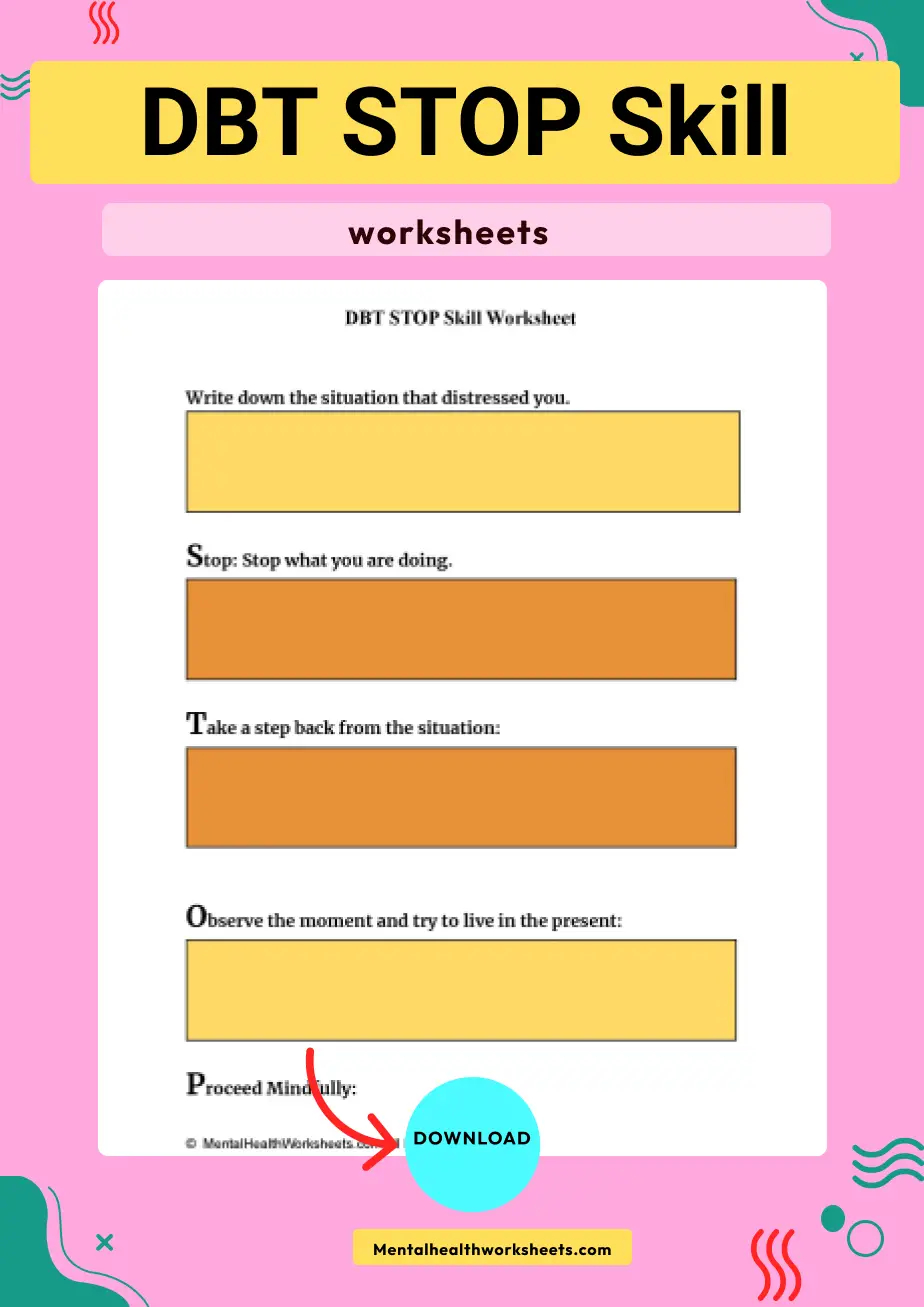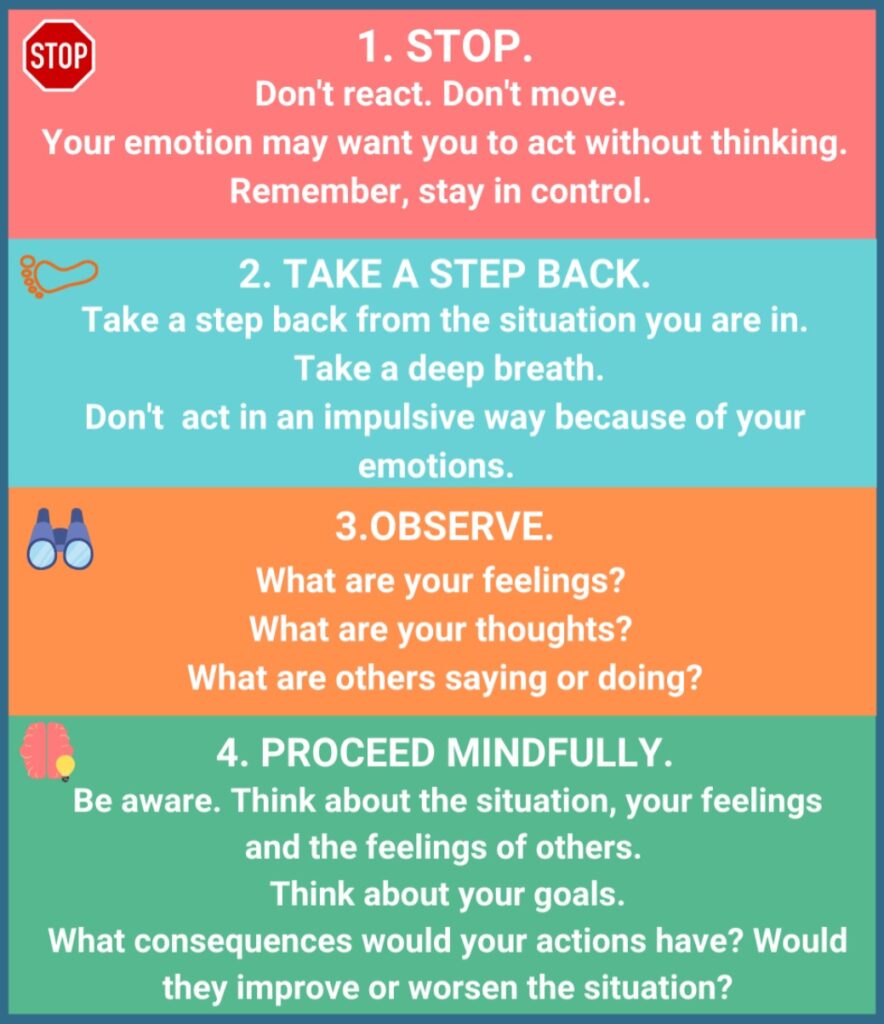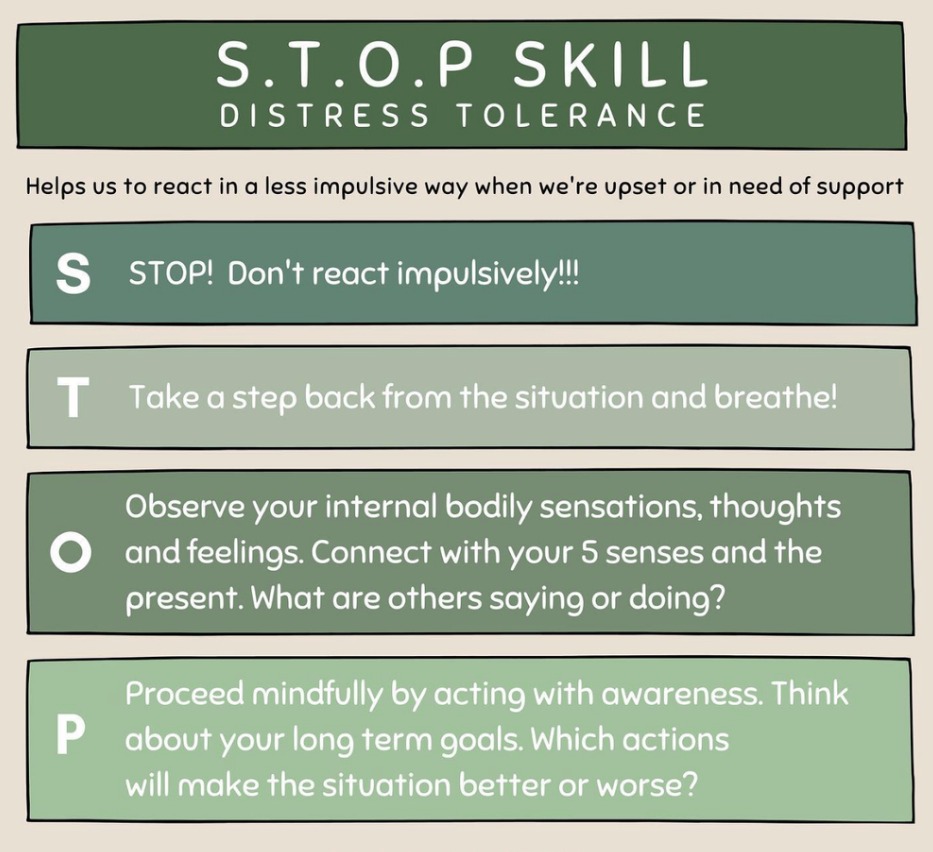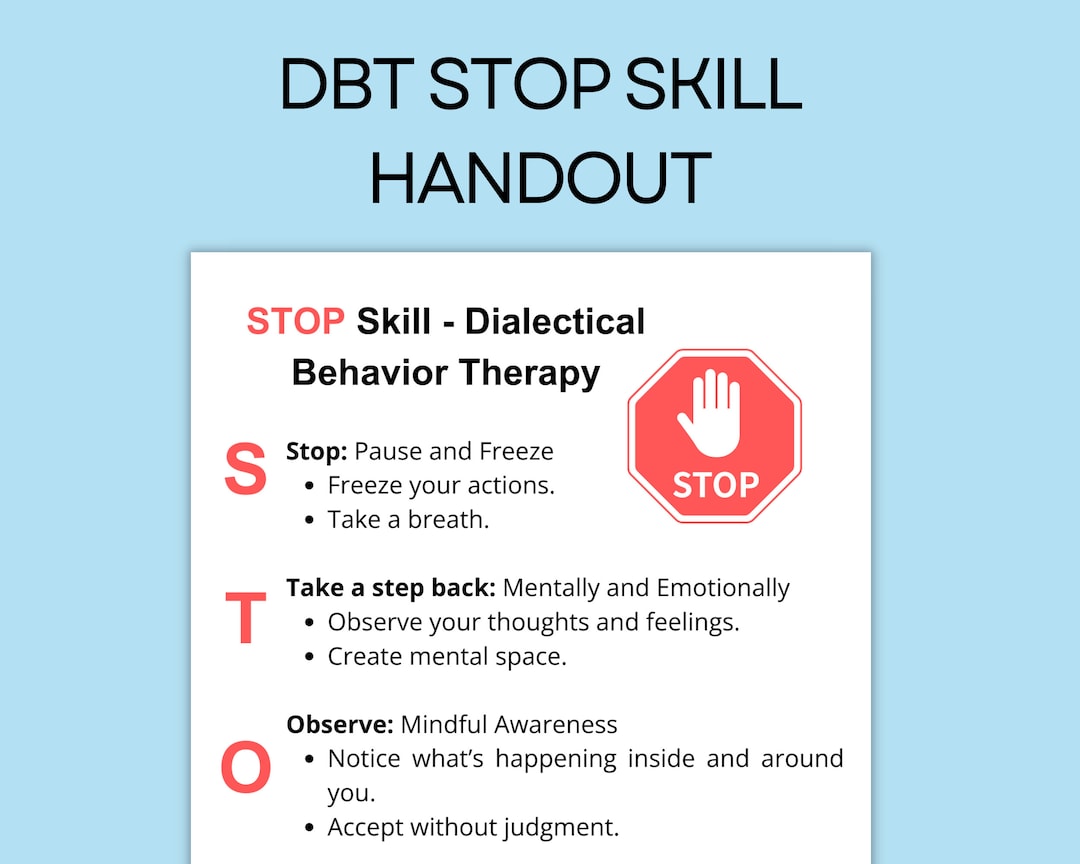Stop Dbt Worksheet - The stop skill is a distress tolerance technique from dialectical behavior therapy (dbt) that helps you manage impulsive behaviors and. Do not move a muscle! When you feel your emotions are about to take control. In deciding what to do, consider your thoughts and feelings, the situation, and other people’s thoughts and feelings. These are skills for tolerating painful events, urges, and emotions when you cannot make things better right away. Your emotions may try to. How to use this skill: Learn how to use the stop skill to manage your emotions and respond effectively to difficult situations. The skill involves stopping, taking a. Topics include emotional regulation, distress tolerance, mindfulness, interpersonal effectiveness, and.
These are skills for tolerating painful events, urges, and emotions when you cannot make things better right away. How to use this skill: When you feel your emotions are about to take control. The skill involves stopping, taking a. Do not move a muscle! Your emotions may try to. Learn how to use the stop skill to manage your emotions and respond effectively to difficult situations. The stop skill is a distress tolerance technique from dialectical behavior therapy (dbt) that helps you manage impulsive behaviors and. In deciding what to do, consider your thoughts and feelings, the situation, and other people’s thoughts and feelings. Topics include emotional regulation, distress tolerance, mindfulness, interpersonal effectiveness, and.
The stop skill is a distress tolerance technique from dialectical behavior therapy (dbt) that helps you manage impulsive behaviors and. When you feel your emotions are about to take control. Your emotions may try to. These are skills for tolerating painful events, urges, and emotions when you cannot make things better right away. The skill involves stopping, taking a. Do not move a muscle! Learn how to use the stop skill to manage your emotions and respond effectively to difficult situations. Topics include emotional regulation, distress tolerance, mindfulness, interpersonal effectiveness, and. How to use this skill: In deciding what to do, consider your thoughts and feelings, the situation, and other people’s thoughts and feelings.
DBT STOP Skill Worksheet (Editable, Fillable, Printable PDF
Topics include emotional regulation, distress tolerance, mindfulness, interpersonal effectiveness, and. Do not move a muscle! Your emotions may try to. The stop skill is a distress tolerance technique from dialectical behavior therapy (dbt) that helps you manage impulsive behaviors and. When you feel your emotions are about to take control.
Printable DBT Stop Skill Printable JD
Do not move a muscle! Your emotions may try to. The skill involves stopping, taking a. In deciding what to do, consider your thoughts and feelings, the situation, and other people’s thoughts and feelings. Learn how to use the stop skill to manage your emotions and respond effectively to difficult situations.
Printable DBT Stop Skill Printable JD
How to use this skill: Learn how to use the stop skill to manage your emotions and respond effectively to difficult situations. The skill involves stopping, taking a. The stop skill is a distress tolerance technique from dialectical behavior therapy (dbt) that helps you manage impulsive behaviors and. When you feel your emotions are about to take control.
Stop Dbt Skill Worksheet
The skill involves stopping, taking a. Your emotions may try to. In deciding what to do, consider your thoughts and feelings, the situation, and other people’s thoughts and feelings. Do not move a muscle! When you feel your emotions are about to take control.
Dbt Stop Skill Worksheet
Your emotions may try to. When you feel your emotions are about to take control. How to use this skill: In deciding what to do, consider your thoughts and feelings, the situation, and other people’s thoughts and feelings. The stop skill is a distress tolerance technique from dialectical behavior therapy (dbt) that helps you manage impulsive behaviors and.
DBT STOP Skill Worksheet Dbt therapy, Dialectical behavior therapy
In deciding what to do, consider your thoughts and feelings, the situation, and other people’s thoughts and feelings. When you feel your emotions are about to take control. Learn how to use the stop skill to manage your emotions and respond effectively to difficult situations. Your emotions may try to. Do not move a muscle!
Dbt Stop Skill Worksheet
In deciding what to do, consider your thoughts and feelings, the situation, and other people’s thoughts and feelings. The stop skill is a distress tolerance technique from dialectical behavior therapy (dbt) that helps you manage impulsive behaviors and. Do not move a muscle! These are skills for tolerating painful events, urges, and emotions when you cannot make things better right.
Printable DBT Stop Skill Printable JD
Learn how to use the stop skill to manage your emotions and respond effectively to difficult situations. The skill involves stopping, taking a. The stop skill is a distress tolerance technique from dialectical behavior therapy (dbt) that helps you manage impulsive behaviors and. Topics include emotional regulation, distress tolerance, mindfulness, interpersonal effectiveness, and. In deciding what to do, consider your.
Printable DBT Stop Skill Printable JD
When you feel your emotions are about to take control. Topics include emotional regulation, distress tolerance, mindfulness, interpersonal effectiveness, and. These are skills for tolerating painful events, urges, and emotions when you cannot make things better right away. Do not move a muscle! How to use this skill:
STOP Skill Handout Sheet DBT Digital Download, Dialectical Behavior
These are skills for tolerating painful events, urges, and emotions when you cannot make things better right away. Topics include emotional regulation, distress tolerance, mindfulness, interpersonal effectiveness, and. When you feel your emotions are about to take control. The stop skill is a distress tolerance technique from dialectical behavior therapy (dbt) that helps you manage impulsive behaviors and. Your emotions.
Topics Include Emotional Regulation, Distress Tolerance, Mindfulness, Interpersonal Effectiveness, And.
Learn how to use the stop skill to manage your emotions and respond effectively to difficult situations. The skill involves stopping, taking a. How to use this skill: These are skills for tolerating painful events, urges, and emotions when you cannot make things better right away.
In Deciding What To Do, Consider Your Thoughts And Feelings, The Situation, And Other People’s Thoughts And Feelings.
Your emotions may try to. The stop skill is a distress tolerance technique from dialectical behavior therapy (dbt) that helps you manage impulsive behaviors and. Do not move a muscle! When you feel your emotions are about to take control.


